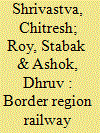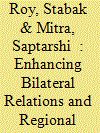|
|
|
Sort Order |
|
|
|
Items / Page
|
|
|
|
|
|
|
| Srl | Item |
| 1 |
ID:
190745


|
|
|
|
|
| Summary/Abstract |
India and China share about 3,488 km long International Boundary, which has three sectors: Western, Middle and Eastern. The Eastern sector comprises two Northeastern states, that is, Arunachal Pradesh measuring 1,124 kms and Sikkim measuring 219 kms, respectively. Due to recent changes in the geopolitical relationship with China, border management and transport infrastructure development have occupied centre stage. In recent years, the Government of India has taken initiatives to develop railway infrastructure in Northeast India. The study will focus on the role of railway transportation in Sino-Indian geopolitical competition. The study is based on secondary data collected from the office of General Manager, Northeast Frontier Railway, the Census of India and reports of Memorandums of Understanding between India and China. The study reveals that railway infrastructure along the border creates geo-psychological pressures on both countries, influencing the divergent geopolitical relationship between India and China. Railway diplomacy is a tool kit of critical geopolitics which reveals the contours of geopolitical competition in borderlands.
|
|
|
|
|
|
|
|
|
|
|
|
|
|
|
|
| 2 |
ID:
193238


|
|
|
|
|
| Summary/Abstract |
The primary objective of this study is to assess the practicality and consequences of establishing railway connectivity between India and Myanmar. By exploring the possible impact of this initiative on the relationship between the two countries and regional collaboration, this study aims to shed light on its potential benefits and challenges. The railway network aims to enhance connectivity between the Northeastern states of India and Myanmar, providing a new trade route with Southeast Asia. The study was based on policy review, meta-data analysis, bibliometric literature review and case studies using geospatial techniques. The results indicate that the proposed railway connectivity has the potential to boost trade, tourism and investment and strengthen regional cooperation. However, significant challenges such as security concerns, financial viability and political stability need to be addressed to realise the potential of railway connectivity fully. The study concludes that strong political will, effective project management and public–private partnerships are crucial for the success of the India–Myanmar railway connectivity and its potential impact on bilateral relations and regional cooperation.
|
|
|
|
|
|
|
|
|
|
|
|
|
|
|
|
|
|
|
|
|